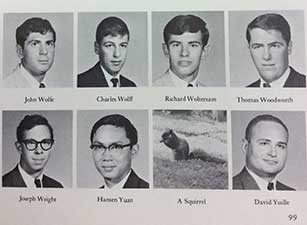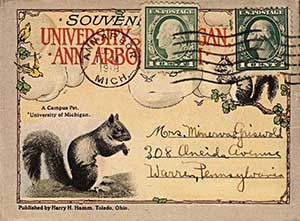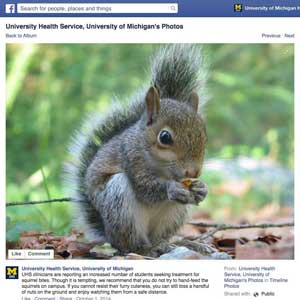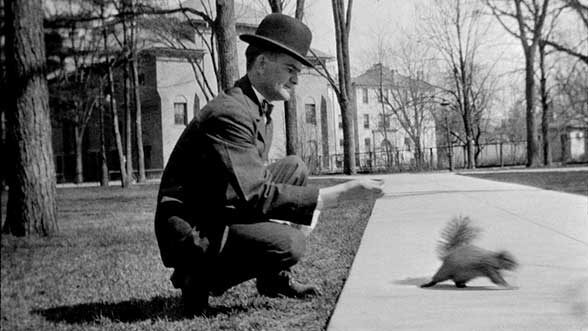Revered

1968 Medical School yearbook, Aequanimitas. Larger image.
As they prepared to graduate, the University of Michigan seniors of 1903 had suggestions for improving their soon-to-be alma mater. Scholarships would be a nice addition, they agreed, as would some new professors and a bar in University Hall, the main academic building.
And this: “More squirrels.”
Michigan has had a very long romance with its campus squirrels, certainly since the days of the Diag as a scrubby wheat field filled with grazing livestock.
Through the years, the darting, chattering, pandering squirrels have been a happy diversion for students, staff, and faculty. The family Sciuridae has been the subject of countless photographs and postcards (“early Ann Arbor settlers”), the recipient of nuts and chips, and a source of amusement and fascination for thousands crisscrossing the campus.
The U-M squirrel has been romanticized, serenaded, protected and parodied. It has its own campus club, which is more than any dog or cat can claim. One would think there was little teaching or research taking place, but only plenty of weighty pondering of the ubiquitous rodent.
Witness Frank E. Robbins, editor of the Michigan Alumnus Quarterly Review, writing in 1958:
“A friend tells me that one of the many squirrels inhabiting our campus has lost all but about an inch of its tail, but still runs about as if nothing had happened, happily fulfilling all the usual functions of a squirrel. All but one, that is — the etymological one; for our word ‘squirrel’ is remotely derived from a couple of Greek words (skia, shade, and ouros, tail) via Latin, Vulgar Latin, and Old French, and is supposed to signify that the critter can sit in the shadow of its own tail.“So the question arises,” Robbins continued, “can this particular specimen still claim full membership in the international brotherhood of squirrels, or must he or she enter the emeritus status?”
Embraced
The sorority girls of Delta Delta Delta loved the squirrels of 1952, or rather knew that the squirrels loved them.

This 1918 postcard describes the squirrel as “a campus pet.” (Image courtesy of Wystan Stevens.) Larger Image.
“All the squirrels in Ann Arbor welcome us,” the sorority wrote in the Michiganensian. “No wonder they’re happy to see us. They eat our cigarettes. They chew our curtains. They bum our crackers.”
Before the Diag, the block M, and the maize and blue, Michigan had its squirrels. They are simply part of the U-M experience.
“An afternoon drive through Ann Arbor residence streets above and at one side of the Campus is a very pleasant relaxation; it soothes with the suggestion of amplitude of time, largeness of aim and quietness of endeavor,” wrote the Michigan Alumnus in 1915. “And where else in the world will squirrels tag you along the streets begging for a nibble of food?”
Studied
In the early days, as the University worked to establish its hold in science and research, squirrels were for study and exhibition. But first they had to be caught.
Alexander Winchell, professor of geology and natural history, ran advertisements in the state’s newspapers in 1856.
“The University of Michigan is desirous of obtaining complete series of specimens illustrating the Natural History of the State, and as this object can be effected only through the cooperation of many individuals, it is hoped that every person into whose hands this circular may come will conceive an interest in forwarding some part of the enterprise.”
Among the “specially desired” mammals: squirrels.
“Those are desired in large quantities and of all ages, and procured at different seasons of the year. Small mammals may be preserved by throwing them as caught into alcohol. The large, (as foxes, wolves, etc.) must be skinned, (retaining feet and skull) and the skin thoroughly rubbed over with arsenic,” Winchell wrote.
In 1867, Winchell reported that J.T. Coleman, a taxidermist in the natural history museum, presented the University with the gifts of a fox squirrel and a gray squirrel. They were built into an exhibit that also featured a mounted black bear and a lynx; the squirrels, stuffed and silent, tottered overhead in tree branches.
Protected

Ann Arbor Argus, 1894. (Image courtesy of the Ann Arbor District Library, Old News Collection.) Larger image.
Some 40 years after the call for specimens, it became illegal to harm a squirrel in Ann Arbor.
The Common Council of 1894 unanimously passed an ordinance protecting the city’s squirrels and birds from hunters or anyone else looking to injure, maim, or kill the creatures. Maximum punishment for offenders was a $25 fine and 30 days in jail.
But squirrels continued to be a target.
“Complaint is made that the squirrels on the campus are being shot by unprincipled persons,” the Ann Arbor Argus reported in 1896. “An example should be made of one or two of the nimrods.”
Probably the editors had no intention of implicating either the Ladies’ Aid Society of the First Congregational Church or the U-M faculty.
But it’s a fact that the Society’s 1899 “Ann Arbor Cook Book” included a recipe for squirrel. (“First catch your squirrel. Skin him, etc. Parboil in a little water in a kettle, add salt, pepper, and enough butter to fry it brown. Then eat. If the animal is tough parboil a little more till he is tender.”)
And when one Olney Belknap was fined $5 ($130 today) for shooting a squirrel in 1903, he told the judge that a “prominent university professor” had paid him to eradicate squirrels that were littering his lawn with pears.
In any case, it remains a crime to injure, torment, poison, or kill a squirrel in Ann Arbor.
Feared

A 2014 warning to U-M students from the University Health Service. Larger Image.
Delivering a campus health lecture in 1914, speaker Anna Scryver painted an ominous scenario. Ground squirrels were running amok in California and carrying fleas, which in turn carried disease.
“I fear for the future of Ann Arbor if the hundreds of tame squirrels now at liberty on the campus of the university are permitted to roam as at present,” she warned. “Is there any reason to doubt that sooner or later our tame squirrels will become bubonic plaque carriers?”
The editors at the Detroit Free Press could only roll their eyes – and sharpen their pencils.
“Mrs. Scryver seems to be a good deal in the position of the bachelor lady who wept for fear that if she married and had a son he might be drowned.”
There is no evidence of bubonic plaque in Michigan, and fretting about fleas on California squirrels bringing disease halfway across the country was currying unnecessary alarm and absurdity. “Still if anyone in Ann Arbor really feels nervous,” the newspaper stated, “we suggest that he procure a squirt gun and occupy the silly season treating the squirrels of the little village to showers of antiseptic solution.”
Politicized

Michiganensian, 1902. Larger image.
The poet Robert Frost had barely settled in as a visiting faculty member in 1921 when a conversation about campus squirrels turned into a local kerfuffle about nature, death, and God.
When informed that Ann Arbor’s squirrels were dying off due to an unknown disease, Frost theorized it was “nature’s way” of correcting overpopulation. “Animals breeding rapidly after a time become a menace for one reason or another. Then comes a scourge and they die off.”
He then suggested that famine, disease, and war have a similar impact when the human population grows too large.
A local paper was indignant. Where Frost implied “nature’s way,” theWashtenaw Post heard “God’s way.”
“How simple. The great war was nothing to be regretted, but simply God’s way of thinning us out!” the paper editorialized.
“The University of Michigan is welcome to Mr. Frost and his theory of God’s way. But there will still be those who believe it is the ignorance of man rather than the goodness of God that brings these scourges upon us.”
The squirrels had no comment.
Gorged
The glut and girth of Ann Arbor squirrels have never failed to amaze.
Zoology Professor Joseph Beale Steere provided an inventory of Ann Arbor mammals to the Ann Arbor Courier in 1880, taking special note of the profusion of fox squirrels and their affinity for the home of fellow faculty member Andrew Ten Brook. The home was located at the corner of South University and Washtenaw avenues, the site of today’s Phi Delta Theta house.

A squirrel of the modern day. (Photo by Corey Seeman.) Larger Image.
“It is quite abundant in this vicinity, and has been so long protected about the houses of Prof. Ten Brook and Mr. Scott, that it is has become half tame, and is frequently seen in other parts of the city. It is usually solitary in its habits, but in the spring large numbers sometimes assemble for some unknown purpose. I saw at least fifty gathered in this way, in the spring of 1877, I think, near Prof. Ten Brook’s house, and others speak of still larger gatherings.”
The pampered life of the squirrel continued as the 20th century unfolded in Ann Arbor, where local realtors made them a selling point. “. . . [T]ame fox squirrels can be found in large numbers in most of the yards in our city. They are so tame that students carry nuts in their pockets and the squirrels come up and take them out of their hands. They build their nests in the trees and about the dwelling houses all over the city.”
Flash forward to the 21st century and Michigan Daily columnist Sarah Rubin:
“The most striking characteristic of the squirrels on campus is their relative size. I come from a nearby small town in Michigan, and our squirrel population isn’t nearly as overweight. The squirrels in my town live in trees. They jump and run on the phone wires and all of the other typical squirrel behavior that looks like it’d be fun to try if I was three inches tall.
“Here, in Ann Arbor, the squirrels are always on the ground. Why?
“Because they’re freaking obese. You have to do a double take to see if it’s a cat or a squirrel walking with you to class. They’ve lost their aero-dynamic powers and they’re too fat to ascend, so they stagnate in the grass.”
Beloved
From his fourth-floor office in Angell Hall, Classics Professor Eugene S. McCarthy spent hours watching the squirrels outside his window. He then regaled Michigan Alumnus readers with the animals’ escapades in a series of articles about Tail-in-Air and his companions Shadow-Tail, Peter Pan, and Topsy, to name a few.
“Tail-in-Air has ‘it.’ All my visitors are attracted by him, and they go to the window to make his more intimate acquaintance,” McCartney wrote in 1935. “Friends who know both him and me are now more solicitous about his health than about mine.”
McCartney was editor of scholarly publications for the graduate school. His office windows faced State Street, but were largely obscured by the facade of Angell Hall that bears an inscription from the Northwest Ordinance. He went so far as to wander the roof of Angell Hall to determine just how the squirrels made their way to his window ledge, and then provided Alumnus readers with a detailed sketch of the building and the squirrels’ routes.“When Tail-in-Air pours forth from the rainspout while I am editing an arid manuscript he is as refreshing as rain during a drought,” he wrote. “He is always welcome, for he makes lighter the burdens of this workaday world.”
McCartney wrote three articles over the course of a year, each one longer and more detailed than its predecessor. His affection for Tail-in-Air and other squirrels bore a timeless quality echoed by all generations on campus.
“I have often paid much more for far less cheer and pleasure and entertainment than my little hyphenated chum provides. I shall do my best to merit his continued confidence and esteem. If the tie that binds is ever broken, he will have to do the breaking.”
(Top image: Feeding squirrels on the Diag in about 1913. Photo courtesy of Barry LaRue.)
This article was reprinted courtesy of the University of Michigan Heritage website. Contents were drawn chiefly from the Michiganensian; Michigan Alumnus; The City of Ann Arbor, by Noah W. Cheever; Ann Arbor Cook Book, by the Ladies’ Aid Society of the First Congregational Church; Michigan Union Publications collection at the Bentley Historical Library; and contemporary news accounts.




Daniel Harrison - B.A. 1972; M.L.S. 1975
While in Library Science school, I worked in the basement of Hatcher Library. We would put peanuts outside the windows for the squirrels. Then we started opening the windows and putting them just inside, on the sills. One squirrel would eventually be bold enough to take the dare, and the rest would follow suit. Soon we were moving the peanuts farther and farther along the ledge inside, so the squirrels had to creep halfway across the room. Then the inevitable happened: one retreating squirrel facing an advancing squirrel on the narrow ledge. Panic ensued. We closed the door and tiptoed away for a well-timed coffee break. Then we put the books back on the shelves, and closed the window. Permanently.
Reply
Kate Kuhlman - 2014
Michigan psychology professor, Dr. Christopher Peterson, a world-renowned positive psychologist, may he rest in peace, wanted to be reincarnated as a Michigan squirrel. I hope he was.
Reply
Sandy Stroud (Plummer) - 1991
I was a music major in voice. Living in Bursley, often I would sing directly to individual squirrels as I walked home and interestingly they appeared to follow me part of the way, enjoying my love!
Reply
Catherine Biondi - 1998
I’m an Ann Frances Millman CEW Scholar and UM-D grad (3.94 GPA, ranked 9th in graduating class, selected as 1998 Honor Scholar for English among many other accolades). I’m now working as an award-winning Comp and Benefits communicator for Ford Motor Company. Between full-time jobs in 2003-2004, I did some temp work for the U. My last assignment was with Student Housing, which was located behind the Student Union. I got to know a squirrel that hung out there and begged passersby for food every day. He had the longest tail I’d ever seen. I wrote a children’s book about him but never pursued publication. Would love to talk to you about it!
Reply
Nancy Knott
I believe you were suppose to write about the squirrels, not yourself!
Reply
Bob Serunkel
Maybe Catherine is a high-achieving squirrel writing about herself and the lesser squirrel she met.
Reply
Marilyn Signer
“supposed”
Reply
Robert F. Woods - 1968
Sounds like there was one person in A2 that voted for Dufus Drumpf – so-called president. Wow – what braggadocio!
Reply
paul kinczkowski - 1993 LSA
I can remember watching a squirrel eat the tulips behind the art museum one day. He went one flower at a time. Bent them down. Peeled off the petals. Then ate the insides. He denuded a whole planter box while I watched. I often carried hazelnuts so I could feed the smaller squirrels.
Reply
Sally Foster - 1971
Does anyone remember the Squirrel Lady, circa 1969-1971?
Reply
John Jarpe - 1971
I absolutely remember the “Squirrel Lady”, Sally Foster! Everyone who spent time on the Diag knew her. She preferred squirrels to people, which, on some days in those turbulent years, was not a bad choice.
Reply
Josh jskarf - 2004
Back at the beginning of Facebook, when Facebook groups were restricted to your University, I was part of a Michigan group called “People Who Swear they Have Seen the Fattest Squirrel Ever”
Reply
Cathy Bordeau - 1985, 1993
When my husband first came to the University of Michigan, he noticed a squirrel waiting to cross the street at the light with the other pedestrians and thought “Wow, even the squirrels are smart here!”
Reply
Laura Harlow
I fed the squirrels for over 15 years outside my 4th floor Hutchins Hall office window. They loved peanut butter sandwich cookies and it was fascinating to watch them separate the cookie like we do an Oreo cookie to get to the center. My favorite squirrel recollection was the wonderful Professor AWB Simpson bringing a student to my office to show me his finger which had been bitten by a squirrel. Prof. Simpson was concerned at my close relationship with the cute little rodents. Upon seeing the student’s injury, I promptly stated “it wasn’t one of my squirrels who bit him!”
Reply
Michael Hackett - 1996
I have a photo of myself feeding a squirrel in front of Angell Hall in the mid-1980s, which I used as the basis for an essay in English 125 in 1992. I didn’t realize how long people had been pampering the Sciurus carolinensis annarborus population.
Reply
David Hall - 1983 -Law
I spent three wonderful years living in the Law Quad. As a homesick One L, I missed my family and pet dog. Quick to the rescue, I met a very bold, yet friendly, squirrel who too lived in the Quad. He greeted me most days en route to class. I assumed he enjoyed my company but realize that my food handouts may have influenced him. Without exaggeration, his routine was to climb up ( and no, not in), my blue jean pants to get his snacks..amazing..
Reply
Kathy boudreau - 1970
There is nothing better that laying on the Diag grass pretending to read, but really watching the squirrels watch me.
Reply
michael orhanen - 1975 Dental
I lived in the dental fraternity house at 1502 HiIl St. While there, a giant squirrel lived in an oak tree in our back parking lot, and also in a large flowering tree in front of the house. Daily, he could be seen in those trees on two particular long sturdy branches. During the night he would line up his arsenal of chestnuts on those branches, and wait for us to exit the house. Then, when we were within range, he pitched those chestnuts at us until his supply was depleted, That grumpy squirrel was there for my last two years in dental school…He was hilarious…….
Reply
Stephen Fuller
I once had an uninvited squirrel try to join me for lunch in my former office on the 2nd floor of Hutchins Hall. I rather abruptly instructed him to leave through the open window and return whence he came, and kept it shut thereafter.
Reply
Szuwei Co - J.D. Candidate, 2017
I lived on the first floor of Cook this year, facing into the law quad, and the little pipsqueaks took to knocking on my window for snacks. By the end of the year, Fatty, a heavily pregnant squirrel, would try to get inside my dorm room. Since that wasn’t really an option, she took to just splaying out on my window sill for hours at a time or scaling the screen in fits of boredom. She also had no issue with my petting her.
There are a good six or so squirrels that I can recognize and who would ‘respond’ to their names if called.
Reply
Angela Kalsi - 2009
During my senior year, I lived in a gorgeous old house on Ann Street with a number of friends, including an exchange student from Germany. On one of her first days in the house, the German student was taken aback by a squirrel which came within a foot of where we sat on the porch, and she exclaimed, “Is that someone’s pet?” The question seemed absurd, but, of course, at that point, I was completely oblivious to the ubiquitous Ann Arbor squirrels and their utter lack of fear around people. In retrospect, it was a fair question considering how comfortable we were with the squirrels in our yard. It is a moment we still laugh about today.
Reply
Jim Shade - Law 1981
Arriving at the Law Quad on bicycle each morning, I would be well armed with peanuts. One critter would climb the bike to the seat and await his or her portion. Another would climb up the leg of my jeans for like purpose. (I had to avoid wearing shorts for that reason.)
Reply
Wystan Stevens - 1970
https://www.flickr.com/search/?w=70251312@N00&q=squirrel
Reply
Adam Rubinstein - 1985
All of my fond memories of the relatively tame rodents eating out of my hands and inhabiting the diag has been tempered by the knowledge that out west some squirrels have tested positive for Yersinia pestis, the agent responsible for bubonic plague. While no one has knowingly contracted the disease from a squirrel (yet?), it’s something to think about.
Reply
robert reed - Ph.D. 1979
While squirrels can carry an assortment of diseases, their repertoire is far less than what homo sapiens are host to. So much so that squirrels run more of a risk being infected by the two legged beast than vice versa. Which reminds me of a mommy squirrel who made a nice home for her babies in my old Volvo. Oh well, it was good exercise to walk to campus that year.
Reply
jeni spamer - 2003, 2006
My favorite memory is of a Diag squirrel who had found the greatest “snack” ever – a whole slice of pizza. The fatty was trying in vain to drag it up a tree. I have always wondered if the squirrel ever abandoned it or just nibbled away until it was light enough to carry.
Reply
Dave Brewster - 1973 & 1978
As an under graduate in the early ’70s, in addition to the pressures of school, ever present and looming over us was the Vietnam War. The Diag — with its trees, interesting people, dogs, squirrels, and birds — was a welcome refuge. One glorious fall day with the sun blazing and the trees in early color, my friends and I were throwing a frisbee. Ken, a tall blonde English major who coaxed a smile from many a coed, missed a throw. This scared a scurry of nearby squirrels being fed, as they often were, by an enigmatic older woman commonly known around campus as the Squirrel Lady. The Squirrel Lady was not happy and loudly scolded Ken for his incredibly rash and rude behavior. As Ken hung his head and tried to apologize, the Squirrel Lady stopped and looked Ken in the eyes as if suddenly recognizing him saying “Oh, I’m so sorry, you have to go to Vietnam and die in the war.” Then she abruptly walked off, causing Ken many sleepless nights and creating a quandary among his friends as to whether this was hilarious or ominously prophetic. Fortunately Ken avoided Vietnam, but to this day I don’t know whether the Squirrel Lady was genuinely empathetic or cleverly vengeful.
Reply